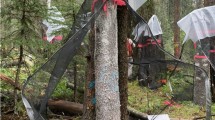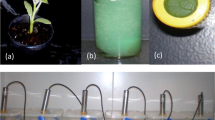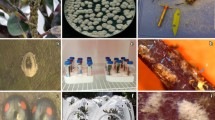Abstract
Selecting entomopathogenic fungal isolates for use as biocontrol agents requires an assessment of their growth and virulence characteristics as affected by environmental conditions. Here we demonstrate a wide temperature and moisture range for colony growth, effective conidial germination and virulence against Pissodes strobi Peck (white pine weevil) of several isolates of Lecanicillium Gams and Zare, an entomopathogenic fungus distributed worldwide and indigenous to forests on Vancouver Island, British Columbia, Canada. In order to examine the potential Lecanicillium as a biological control agent, the pathogenicity of isolates collected from different geographical locations on P. strobi cadavers was assessed, and colony growth at different temperatures was evaluated. Colony growth was evident between 5 and 30°C, with optimal growth occurring at 25°C. Various combinations of water activity (0.55, 0.76, 0.85 and 0.99 a w) and temperature (10, 15, 20, and 25°C) were also used to evaluate environmental impacts on conidial germination and cumulative mycosis of adult P. strobi. Certain Lecanicillium isolates displayed xerophilic (0.85 a w) or psychrophilic (10°C) growth optima. Ultimately, identifying the abiotic limits of this entomopathogenic fungus will be used to determine which isolates have potential for future in situ biocontrol trials.
Similar content being viewed by others
References
Abbott WS (1925) A method for computing the effectiveness of an insecticide. J Econ Entomol 18:265–267
Butt TM, Jackson C, Magan N (2001) Introduction––fungal biological control agents: progress, problems and potential. In: Butt TM Jackson C Magan N (eds) Fungi as biocontrol agents: progress, problems and potential. CABI Publishing, New York, pp 1–8
Chandler D, Heale JB, Gillespie AT (1994) Effect of osmotic potential on the germination of conidia and colony growth of Verticillium lecanii. Mycol Res 98:384–388
Dhingra OD, Sinclair JB (1995) Basic plant pathology methods. 2nd edn. CRC Press, Boca Raton, p 402
Drummond JD, Heale JB, Gillespie AT (1987) Germination and effect of reduced humidity on expression of pathogenicity in Verticillium lecanii against the glasshouse whitefly Trialeurodes vaporariorum. Ann Appl Biol 111:193–201
Fargues J, Goettel MS, Smits N, Ouedraogo A, Rougier M (1997) Effect of temperature on vegetative growth of Beauveria bassiana isolates from different origins. Mycologia 89:383–392
Fargues J, Luz C (1998) Effects of fluctuating moisture and temperature regimes on sporulation of Beauveria bassiana on cadavers of Rhodnius prolixus. Biocontrol Sci Technol 8:323–334
Hajek AA (1997) Ecology of terrestrial fungal entomopathogens. In: Jones (ed), Advances in microbial ecology, vol 15. Plenum Press, New York, pp 193–249
Hall RA (1981) The fungus Verticillium lecanii as a microbial insecticide against aphids and scales. In: Burges HD (ed) Microbial control of pests and plant diseases. 1970–1980. Academic Press, New York, pp 483–498
Hall RA (1982) A new insecticide against greenhouse aphids and whitefly: the fungus, Verticillium lecanii. Ohio Florists’ Assoc Bull 626:3–4
Hall RA, Burges HD (1979) Control of aphids in glasshouses with the fungus Verticillium lecanii. Ann Appl Biol 93:235–246
Hsiao WF, Bidochka MJ, Khachatourians GG (1992) Effect of temperature and relative humidity on the virulence of the entomopathogenic fungus, Verticillium lecanii, towards the oat-bird berry aphid, Rhopalosiphum padi (Hom., Aphididae). J Appl Entomol 114:484–490
Inglis D, Goettel MS, Butt TM, Strasser H (2001) Use of hyphomycetous fungi for managing insect pests. In: Butt TM, Jackson C, Magan N (eds) Fungi as biocontrol agents: progress, problems and potential. CABI Publishing, New York, pp 23–69
Jackson CW, Heale JB, Hall RA (1985) Traits associated with virulence to the aphid Macrosiphoniella sanborni in eighteen isolates of Verticillium lecanii. Ann Appl Biol 105:39–48
Kope HH, Peterson M, Alfaro R (2000) Pathogenicity of Verticillium lecanii to Pissodes strobi, Can J Plant Pathol 22:187 (Abstract)
Kope HH, Leal I. (2005) A new species of Lecanicillium isolated from the white pine weevil, Pissodes strobi. Mycotaxon 94:331–340
Kope HH, Alfaro RI, Lavallee R. (2006) Virulence of the entomopathogenic fungus Lecanicillium (Deuteromycota: Hyphomycetes) to Pissodes strobi (Coleoptera: Curculionidae). Can Entom 138:253–262
Magan N (2001) Physiological approaches to improving the ecological fitness of fungal biocontrol agents. In: Butt TM, Jackson C, Magan N (eds) Fungi as biocontrol agents: progress, problems and potential. CABI Publishing, New York, pp 239–251
McCammon SA, Rath AC (1994) Separation of Metarhizium anisopliae strains by temperature dependent germination rates. Mycol Res 98:1253–1257
Milner RJ, Lutton GG (1986) Dependence of Verticillium lecanii (Fungi:Hyphomycetes) on high humidities for infection and sporulation using Myzus persicae (Homoptera:Aphidae) as host. Environ Entomol 15:380–382
Rath AC, Anderson GC, Worledge D, Koen TB (1995) The effect of low temperatures on the virulence of Metarhizium anisopliae (DAT F-001) to the Subterranean Scarab, Adoryphorus couloni. J Invertebr Pathol 65:186–192
Roddam LF, Rath AC (1997) Isolation and characterization of Metarhizium anisopliae and Beauveria bassiana from Subantarctic Macquarie Island. J Invertebr Pathol 69:285–288
Silver GT (1968) Studies on the Sitka spruce weevil, Pissodes sitchensis, in British Columbia. Can Entomol 100:93–110
Steenberg T, Humber RA (1999) Entomopathogenic potential of Verticillium and Acremonium species (Deuteromycotina: Hyphomycetes). J Invertebr Pathol 73:309–314
Vidal C, Fargues J, Rougier M, Smits N (2003) Effect of air humidity on the infection potential of Hyphomycetous fungi as mycoinsecticides for Trialeurodes vaporariorum. Biocontrol Sci Technol 13:183–198
Vidal C, Fargues J, Lacey LA (1997) Intraspecific variability of Paecilomyces fumosoroseus: effect of temperature on vegetative growth. J Invertebr Pathol 70:18–28
Yip HY, Rath AC, Koen TB (1992) Characterization of Metarhizium anisopliae isolates from Tasmanian pasture soils and their pathogenicity to redheaded cockchafer (Coleoptera: Scarabaeidae: Adoryphorus couloni). Mycol Res 96:92–96
Zar JH (1999) Biostatistical analysis. 4th edn. Englewood Cliffs, New Jersey: Prentice Hall Inc
Zare R, Gams W (2001) A revision of Verticillium section Prostrata. IV. The genera Lecanicillium and Simplicillium gen nov. Nova Hedwigia 73:1–50
Zare, R, Gams, W (2003a). IMI Descriptions of fungi and bacteria. No. 1566, Lecanicillium longisporum
Zare, R, Gams, W (2003b) IMI Descriptions of fungi and bacteria. No. 1567, Lecanicillium muscarium
Acknowledgments
The authors would like to acknowledge the funding supplied by Natural Resources Canada (Canadian Forest Service, Enhanced Pest Management Methods program) for this ECOBIOM (Extended Collaboration on Biological Control of Forest Insects or Pathogenic Microorganisms) project. The authors also thank Koppert Canada Ltd. for providing Mycotal® and Vertalec® for the experiments. Technical support provided by George Brown and Lara van Akker was indispensable.
Author information
Authors and Affiliations
Corresponding author
Rights and permissions
About this article
Cite this article
Kope, H.H., Alfaro, R.I. & Lavallée, R. Effects of temperature and water activity on Lecanicillium spp. conidia germination and growth, and mycosis of Pissodes strobi . BioControl 53, 489–500 (2008). https://doi.org/10.1007/s10526-007-9087-z
Received:
Accepted:
Published:
Issue Date:
DOI: https://doi.org/10.1007/s10526-007-9087-z




